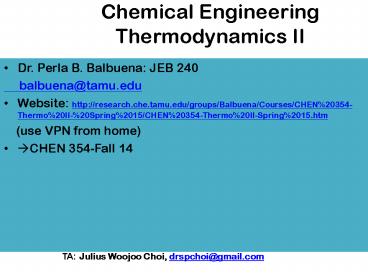Chemical Engineering Thermodynamics II - PowerPoint PPT Presentation
1 / 23
Title: Chemical Engineering Thermodynamics II
1
Chemical Engineering Thermodynamics II
- Dr. Perla B. Balbuena JEB 240
- balbuena_at_tamu.edu
- Website http//research.che.tamu.edu/groups/Balbu
ena/Courses/CHEN20354-Thermo20II-20Spring2015/
CHEN20354-Thermo20II-Spring2015.htm - (use VPN from home)
- ?CHEN 354-Fall 14
TA Julius Woojoo Choi, drspchoi_at_gmail.com
2
TAs office hours
- Julius Woojoo Choi, drspchoi_at_gmail.com
- Office hours Thursdays, 4-5pm, Office 613
3
TEAMS
- Please group in teams of 4-5 students each
- Designate a team coordinator
- Team coordinator Please send an
- e-mail to balbuena_at_tamu.edu stating the names
of all the students in your team (including
yourself) no later than next Monday - First HW is due January 28.
4
Introduction to phase equilibrium
- Chapter 10 (but also revision from Chapter 6)
5
Equilibrium
- Absence of change
- Absence of a driving force for change
- Example of driving forces
- Imbalance of mechanical forces gt work (energy
transfer) - Temperature differences gt heat transfer
- Differences in chemical potential gt mass transfer
6
Energies
- Internal energy, U
- Enthalpy H U PV
- Gibbs free energy G H TS
- Helmholtz free energy A U - TS
7
Phase Diagram Pure Component
f
e
d
c
b
a
- What happens from (a) to (f) as volume is
compressed at constant T.
8
P-T for pure component
9
P-V diagrams pure component
10
Equilibrium condition for coexistence of two
phases (pure component)
- Review Section 6.4
- At a phase transition, molar or specific values
of extensive thermodynamic properties change
abruptly. - The exception is the molar Gibbs free energy, G,
that for a pure species does not change at a
phase transition
11
Equilibrium condition for coexistence of two
phases (pure component, closed system)
- d(nG) (nV) dP (nS) dT
- Pure liquid in equilibrium with its vapor, if a
differential amount of liquid evaporates at
constant T and P, then - d(nG) 0
- n constant gt ndG 0 gt dG 0
- Gl Gv
- Equality of the molar or specific Gibbs free
energies (chemical potentials) of each phase
12
Chemical potential in a mixture
- Single-phase, open system
mi Chemical potential of component i in the
mixture
13
Phase equilibrium 2-phases and n components
- Two phases, a and b and n components
- Equilibrium conditions
- mia mib (for i 1, 2, 3,.n)
- Ta Tb
- Pa Pb
14
A liquid at temperature T
A liquid at temperature T in a closed container
- The more energetic particles escape
Vapor pressure
15
Fugacity of 1 f1
Fugacity of 2 f2
16
For a pure component
- ma mb
For a pure component, fugacity is a function of T
and P
17
For a mixture of n components
- mia mib for all i 1, 2, 3, n
- in a mixture
Fugacity is a function of composition, T and P
18
Lets recall Raoults law for a binary
We need models for the fugacity in the vapor
phase and in the liquid phase
19
Raoults law
20
Raoults law
- Model the vapor phase as a mixture of ideal
gases - Model the liquid phase as an ideal solution
21
VLE according to Raoults law
22
(No Transcript)
23
Homework 1download from web siteDue
Wednesday, 1/28































